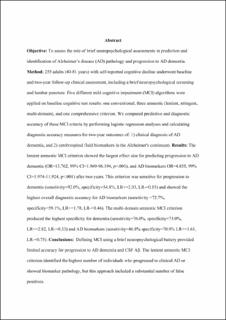Predictive and diagnostic utility of brief neuropsychological assessment in detecting Alzheimer's pathology and progression to dementia
Eliassen, Ingvild Vøllo; Fladby, Tormod; Kirsebom, Bjørn-Eivind; Waterloo, Knut; Eckerström, Marie; Wallin, Anders; Bråthen, Geir; Aarsland, Dag; Hessen, Erik
Peer reviewed, Journal article
Accepted version
Permanent lenke
https://hdl.handle.net/11250/2735562Utgivelsesdato
2020Metadata
Vis full innførselSamlinger
Sammendrag
Objective: To assess the role of brief neuropsychological assessments in prediction and identification of Alzheimer’s disease (AD) pathology and progression to AD dementia. Method: Adults (N = 255; range = 40–81 years) with self-reported cognitive decline underwent baseline and 2-year follow-up clinical assessment, including a brief neuropsychological screening and lumbar puncture. Five different mild cognitive impairment (MCI) algorithms were applied on baseline cognitive test results: one conventional, three amnestic (lenient, stringent, multidomain), and one comprehensive criterion. We compared predictive and diagnostic accuracy of these MCI criteria by performing logistic regression analyses and calculating diagnostic accuracy measures for 2-year outcomes of (1) clinical diagnosis of AD dementia and (2) cerebrospinal fluid biomarkers in the Alzheimer’s continuum. Results: The lenient amnestic MCI criterion showed the largest effect size for predicting progression to AD dementia (OR = 13.762, 99% CI = 1.969–96.194, p = .001) and AD biomarkers (OR = 4.855, 99% CI = 1.974–11.924, p < .001) after 2 years. This criterion was sensitive for progression to dementia (sensitivity = 92.0%, specificity = 54.8%, positive likelihood ratio [LR+] = 2.03, LR− = 0.15) and showed the highest overall diagnostic accuracy for AD biomarkers (sensitivity = 72.7%, specificity = 59.1%, LR+ = 1.78, negative likelihood ratio [LR−] = 0.46). The multidomain amnestic MCI criterion produced the highest specificity for dementia (sensitivity = 76.0%, specificity = 73.0%, LR+ = 2.82, LR− = 0.33) and AD biomarkers (sensitivity = 46.8% specificity = 70.9% LR+ = 1.61, LR− = 0.75). Conclusions: Defining MCI using a brief neuropsychological battery provided limited accuracy for progression to AD dementia and cerebrospinal fluid Aβ. The lenient amnestic MCI criterion identified the highest number of individuals who progressed to clinical AD or showed biomarker pathology, but this approach included a substantial number of false positives. (PsycInfo Database Record (c) 2020 APA, all rights reserved)
